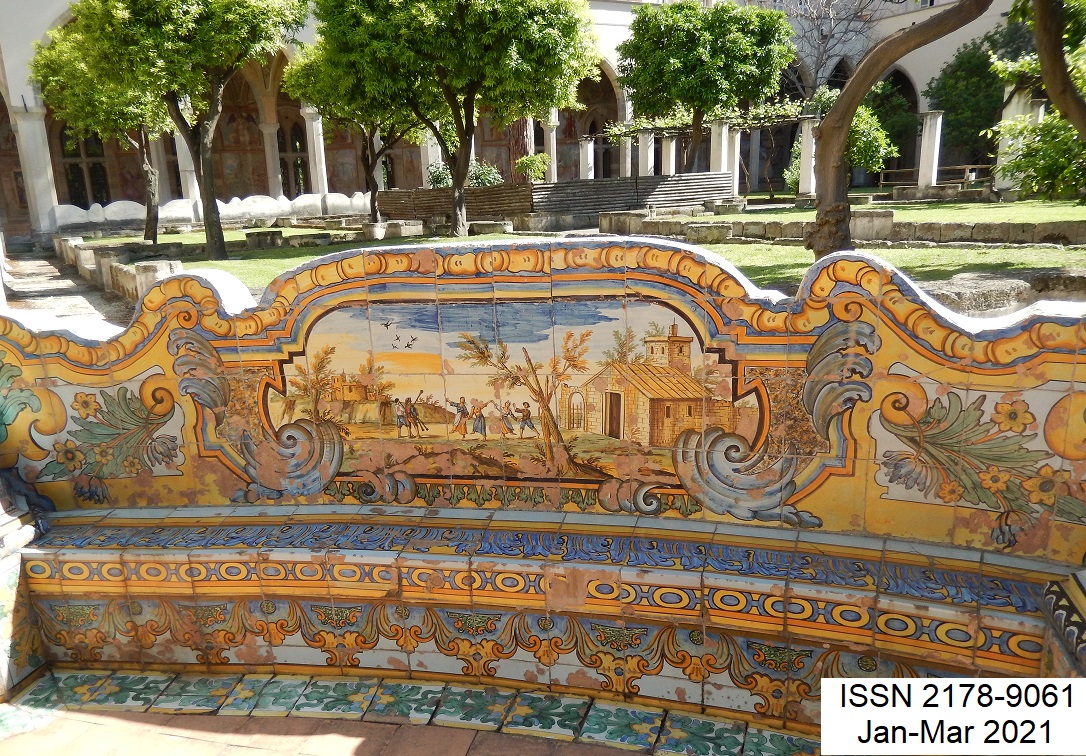Comportamento Planejado, Comportamento Passado e Familiaridade: Análise de Eficiência destes Preditores na Intenção de Ir à Vesperata de Diamantina-MG, Brasil / Theory of Planned Behavior, Past Behavior and Familiarity: Analysis of the Efficiency of these Predictors in the Intention to Visit Diamantina-MG Vesperata, Brazil
Palavras-chave:
Turismo, Tourism, Teoria do Comportamento Planejado, Theory of Planned Behavior, Familiaridade, Familiarity, Comportamento Passado, Past Behavior, Diamantina Vesperata, Minas Gerais, Brasil, Brazil.Resumo
RESUMO
O turismo é um importante setor econômico. Entender a intenção de viagem das pessoas pode ser útil para o planejamento dos destinos, no atendimento à demanda da melhor forma possível. Nesse sentido, este estudo tem como objetivo avaliar o que influenciaria a intenção de ir à Vesperata de Diamantina, no Estado de Minas Gerais, utilizando para tal a Teoria do Comportamento Planejado, com a inclusão dos construtos comportamento passado e familiaridade. Para tanto, foi realizada pesquisa bibliográfica para elaboração de questionário, seguida de pesquisa quantitativa com 125 respondentes, sendo 101 válidos. Os resultados encontrados demonstraram relevância na inclusão dos novos construtos, que apresentaram efeito positivo na intenção de ir ao evento. Por outro lado, a atitude e a norma subjetiva, não apresentaram efeitos significativos na intenção, corroborando com estudos que tratam da complexidade da escolha de um destino turístico e da dificuldade de previsão da intenção, como em outros comportamentos mais comuns.
PALAVRAS-CHAVE
Turismo; Teoria do Comportamento Planejado; Comportamento Passado; Familiaridade; Vesperata de Diamantina, Minas Gerais, Brasil.
ABSTRACT
Tourism is an important economic sector. Understanding people's travel intentions can be useful for planning destinations, meeting demand as well as possible. In this sense, this study aims to assess what would influence the intention to go to the Diamantina Vesperata, in the State of Minas Gerais [Brazil], using the Theory of Planned Behavior for this purpose, with the inclusion of the constructs past behavior and familiarity. The methodology included bibliographic research for questionnaire elaboration, followed by quantitative research with 125 respondents, 101 of which are valid. The results showed relevance in the inclusion of the new constructs, which had a positive effect on the intention to attend the event. On the other hand, the attitude and the subjective norm did not present significant effects on the intention, corroborating with studies that deal with the complexity of the choice of tourist destination and the difficulty of forecasting the intention, as in other more common behaviors.
KEYWORDS
Tourism; Theory of Planned Behavior; Familiarity; Past Behavior; Diamantina Vesperata, Minbas Gerais, Brazil.
AUTORIA
Cristiane Gontijo Araújo - Mestranda na Universidade Federal de Minas Gerais, Belo Horizonte, Minas Gerais, Brasil. Currículo: http://orcid.org/0000-0003-2651-5187 E-mail: crisssgontijo@gmail.com
Isabela Gontijo Tolentino - Mestranda na Universidade Federal de Minas Gerais, Belo Horizonte, Minas Gerais, Brasil. Currículo: http://orcid.org/0000-0002-1908-1686 E-mail: isabelagtolentino@gmail.com
REFERÊNCIAS
Ajzen, I. (1991). The theory of planned behavior. Organizational Behaviour and Human Decision Processes, 50(2), 179-211. Link
Ajzen, I., & Fishbein, M. (1980). Understanding Attitudes and Predicting Social Behavior. New Jersey: Prentice-Hall.
Alves, M. C., & Nascimento, A. F. (2014). Controvérsias analíticas sobre a turistificação da musicalidade diamantinense: o caso das Vesperatas. Cenário - Revista Interdisciplinar em Turismo e Território, 2(2), 123-139. Link
Al Ziadat, M. T. (2014). Application of planned behavior theory in Jordanian tourism. International Journal of Marketing Studies, 6(2), 105-116. Link
Bentler, P. M., & Speckart, G. (1979). Models of attitude-behavior relations. Psychological Review, 86(5), 452-464. Link
Bianchi, C., Milberg, S., & Cuneo, A. (2017). Understanding travelers' intentions to visit a short versus long-haul emerging vacation destination: the case of Chile. Tourism Management, 59, 312-324. Link
Chien, G. C. L., Yen, I. Y., & Hoang, P-Q. (2012). Combination of theory of planned behaviour and motivation: an exploratory study of potential beach-based resorts in Vietnam. Asia Pacific Journal of Tourism Research, 17(5), 489-508. Link
Diehl, A. A., & Tatim, D. C. (2004). Pesquisa em Ciências Sociais Aplicadas: métodos e técnicas. São Paulo: Prentice Hall.
Fishbein, M., & Ajzen, I. (1975). Belief, Attitude, Intention, and Behavior: an introduction to the theory and research. Massachusetts: Addison-Wesley.
Fornell, C., & Larcker, D. F. (1981). Evaluating structural equation models with unobservable variables and measurement error. Journal of Marketing Research, 18(1), 39-50. Link
Fredricks, A. J., & Dossett, D. L. (1983). Attitude-behavior relations: A comparison of the Fishbein-Ajzen and the Bentler-Speckart models. Journal of Personality and Social Psychology, 45(3), 501-512. Link
Fundação João Pinheiro. (2017). Economia do Turismo de Minas Gerais: 2010 a 2014. Estatísticas & Informações: Indicadores Econômicos. Belo Horizonte: Fundação João Pinheiro.
Gonçalvez, C. C. S., & Castellane, L. (2018). Determinantes do valor adicionado do turismo de Minas Gerais: uma análise com modelos de dados em painel. Marketing & Tourism Review, 3(1), 1-19. Link
Guimarães, E. P., & Ferreira, W. R. (2006). Turismo de eventos e seus impactos: o caso da Vesperata em Diamantina - MG. Reuna, 11(3), 71-95. Link
Hair Jr., J. F., Hult, T. M., Ringle, C. M. E., & Sarstedt, M. (2014). A Primer on Partial Least Squares Structural Equation Modeling (PLS-SEM). Los Angeles: Sage.
Han, H., Lee, S., & Lee, C. K. (2011). Extending the theory of planned behaviour: visa exemptions and the traveller decision-making process. Tourism Geographies, 13(1), 45-74. Link
Henseler, J., Ringle, C. M., & Sinkovics, R. R. (2009). The use of partial least squares path modeling in international marketing. Advances in International Marketing, 20, 277-319. Link
Hsu, M-H., Yen, C-H., Chiu, C-M., & Chang, C-M. (2006). A longitudinal investigation of continued online shopping behavior: An extension of the theory of planned behavior. International Journal of Human-Computer Studies, 64(9), 889-904. Link
Hsu, C. H. C., & Huang S. (2012). An extension of the theory of planned behavior model for tourists. Journal of Hospitality and Tourism Research, 36(3), 390-417. Link
Hsu, M-C. (2013). The management of sports tourism: A causal modelling test of the theory of planned behaviour. International Journal of Management, 30(2), 474-496. Link
Lam, T., & Hsu, C. H. C. (2006). Predicting behavioural intention of choosing a travel destination. Tourism Management, 27(4), 589-599. Link
Lee, M., Han, H., & Lockyer, T. (2012). Attracting Japanese tourists for medical tourism experience. Journal of Travel & Tourism Marketing, 29(1), 69-86. Link
Martin, D. S., Ramamonjiarivelo, Z., & Martin, W. S. (2011). Medtour: A scale for measuring medical tourism intentions. Tourism Review, 66(1/2), 45-56. Link
Oliveira, R. A., Miranda, I. P., & Amaral, J. P. S. (2016). Gestão da Informação: o papel dos observatórios e turismo brasileiros para a tomada de decisão do setor público. Marketing & Tourism Review, 1(2), 1-31. Link
Phetvaroon, K. (2006). Application of the theory of planned behaviour to select a destination after a crisis: a case study of Phuket, Thailand. Unpublished PhD Thesis, Oklahoma State University. Link
Pires, M. C. (2017). Das viagens dos cientistas no século xix aos modernistas: a mineiridade e o despertar do turismo das cidades históricas de Minas Gerais, Brasil. Rosa dos Ventos – Turismo e Hospitalidade, 9(3), 405-416. Link
Quintal, V. A., Lee, J. A., & Soutar, G. N. (2010). Risk, uncertainty, and the theory of planned behavior: a tourism example. Tourism Management, 31(6), 797-805. Link
Roseta, P.; Sousa, B.B.; Roseta, L. (2020). Determiners in the consumer’s purchase decision process in ecotourism contexts: a Portuguese case study. Geosciences, 10(6), 1-18. Link
Samara, B. S., & Barros, J. C. (2002). Pesquisa de Marketing – conceitos e metodologia. São Paulo: Prentice Hall.
Shen, S., Schüttemeyer, A., & Braun, B. (2009). Visitors’intention to visit World Cultural Heritage sites: An empirical study of Suzhou, China. Journal of Travel & Tourism Marketing, 26(7), 722-734. Link
Silva, D. R., & Sant’anna, P. A. (2015). Turismo e afirmação da identidade cultural: impactos psicossociais da atividade turística em Diamantina. Turismo - Visão e Ação, 17(1), 150-178. Link
Silveira, C. E., & Medaglia, J. (2014). Perfil da demanda turística real de Diamantina e região: características de viagem, motivações, percepções & expectativas. Diamantina: UFVJM, 2014. Link
Sousa, B., & Alves, G. (2019). The role of relationship marketing in behavioural intentions of medical tourism services and guest experiences. Journal of Hospitality and Tourism Insights, 2(3), 224-240. Link
Sparks, B. A., & Pan, G. W. (2009). Chinese outbound tourists: unerstanding their attitudes, constraints and use of information sources. Tourism Management, 30(4), 483-494. Link
World Travel & Tourism Council. (2019). Travel & Tourism Economic Impact 2019 World. Link
Yang, J., Yuan, B., & Hu, P. (2009). Tourism destination image and visit intention: examining the role of familiarity. Journal of China Tourism Research, 5(2), 174-187. Link
Yuzhanin, S., & Fisher, D. (2016). The efficacy of the theory of planned behavior for predicting intentions to choose a travel destination: a review. Tourism Review, 71(2), 135-147. Link
PROCESSO EDITORIAL
Recebido: 18 MAI 20; Aceito: 15 OUT 20.
Downloads
Publicado
Como Citar
Edição
Seção
Licença
Autores que publicam nesta revista concordam com os seguintes termos:
Os Autores mantém os direitos autorais e concedem à revista o direito de primeira publicação, com o trabalho simultaneamente licenciado sob a Creative Commons Attribution License que permitindo o compartilhamento do trabalho com reconhecimento da autoria do trabalho e publicação inicial nesta revista.
Autores têm autorização para assumir contratos adicionais separadamente, para distribuição não-exclusiva da versão do trabalho publicada nesta revista (ex.: publicar em repositório institucional ou como capítulo de livro), com reconhecimento de autoria e publicação inicial nesta revista.
Autores têm permissão e são estimulados a publicar e distribuir seu trabalho online (ex.: em repositórios institucionais ou na sua página pessoal) a qualquer ponto antes ou durante o processo editorial, já que isso pode gerar alterações produtivas, bem como aumentar o impacto e a citação do trabalho publicado (Veja O Efeito do Acesso Livre).








